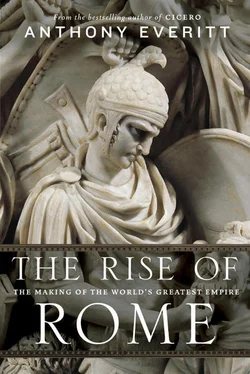The old man was then taken to Rome, where he advised the Senate on how to drain the lake. Not surprisingly, he recommended the technology of his homeland—the exacavation of a cuniculus . This was confirmed by Delphi, where the Pythia was for once remarkably un-Delphic; the priestess straightforwardly suggested that the excess water from the lake be used to irrigate the fields. Once that was done, Veii would fall. The Romans swiftly complied and drained the lake down to its original level.
It is hard to know what to make of this tale. At first sight, it seems preposterous and obviously legendary; but, as so often with early Roman history, a substratum of fact can be detected. There is indeed an ancient outflow tunnel from the Alban Lake that can be seen to this day, although exactly when it was originally constructed is uncertain. (It is not far from Castel Gandolfo, the Pope’s summer residence.) If there was a rationale for the drain, apart from the musings of an antique seer, it may have been designed to prevent seepage into a malaria-generating bog. In other words, it was a health and safety project that, for some unguessable reason, imaginative Roman authors translated into a prediction of Veii’s doom.
We have not heard the last of cuniculi . One of Rome’s most celebrated heroes was elected to the emergency post of dictator and entrusted with the task of bringing the siege to a successful conclusion. This was Marcus Furius Camillus, who, during a long career, was the holder of every senior office in the Republic and five times a dictator. He arranged for the digging of a tunnel underneath Veii’s central fortress, no easy task, as Livy describes it:
This work was now begun, and to keep it going without intermission the men engaged on it were divided into six parties, working six hours each in rotation—as continuous labor underground would have broken them up. The orders were that the digging should go on day and night until the tunnel was complete and a way opened into the enemy citadel.
The crisis of the campaign was approaching. Like most of his compatriots, Camillus was plagued by superstitious fears. For him, it was crucial that he win over to his cause the gods of Veii and, in particular, the city’s divine protectress (and his own favorite in the Olympian canon), Juno, known in Veii as the Etruscan Great Goddess, Uni Teran. Her shrine in the citadel housed an archaic wooden statue of her, a highly prized object of reverence. The Romans had a ceremony for every occasion, and at this crucial juncture Camillus conducted an evocatio —a calling out of the deity from her home at Veii. At an army parade, he called on Juno to “leave this town where you now dwell and follow our victorious arms into our city of Rome, your future home, which will receive you in a temple worthy of your greatness.”
The tunnel was a great success. It was said that the ruler of Veii was offering a sacrifice, and a priest declared that he who carved up the victim’s entrails would be victorious in the war. The diggers overheard the remark and immediately broke through the floor into the fortress, snatched the entrails, and took them at once to Camillus. Even Livy’s credulity was stretched. He wrote that this tale was “too much like a romantic stage play to be taken seriously. I feel it is hardly worth attention either for affirmation or denial.”
However, once again, archaeologists have found a pea of fact beneath a mattress of invention. Excavations at the spot on the Veian peninsula where the Romans must have encamped have shown that the rampart ran over some earlier drainage cuniculi . They had been filled in with tightly packed shards, stone, and earth, presumably with defense in mind. It is hard to resist the conjecture that the Romans discovered one or more of these tunnels, emptied them out, and went on to storm the city.
Whatever the case, Veii fell to a determined assault. There was much slaughter, but Camillus ordered his men to spare everyone not bearing arms. He was not sentimental, though, and Veii was emptied and destroyed. On the following day, all movable goods were taken from the city and the surviving townsfolk were offered for sale as slaves. (In fact, it would seem that the market could not absorb such a large number of people. Now that the Veientine state had been abolished, there was nothing else that could be done with the unsold remainder but to give them the only civic status available, Roman citizenship.)
Then it was time to transport Juno and the temple treasures to Rome. Young soldiers were detailed to lift the statue from its pedestal, an act that seemed to them like sacrilege. For a lark, one of the boys shouted, “Juno, do you want to go to Rome?” The statue nodded its head in awe-inspiring reply. Livy was having none of this, either:
We are told, too, that words were uttered, signifying assent. In any case—fables apart—she was moved from her place with only the slightest application of mechanical power, and was light and easy to move—almost as if she came of her own free will—and was taken undamaged to her eternal dwelling place on the Aventine, whither the dictator had called her in his prayer.
Juno was given a temporary base, probably the plebeian sanctuary of Diana, while Camillus lived up to his word and built a new temple nearby, which he dedicated to the Queen of Heaven a few years after the destruction of Veii. We can only presume that, for the time being, the goddess had set aside her long enmity of Rome, mollified by an attractive new home.
The city became completely uninhabited, as a first-century poet lamented: “How sad, ancient Veii! You were once a mighty kingdom and a throne of gold was set in your market place. Now inside your walls the shepherd loiters and sounds his horn. Men reap cornfields above your graves.”
The Romans were hugely proud of their victory. Claiming that the siege had lasted ten years, they presented the long campaign against Veii as their version of the Trojan War. And, strategically, it was indeed a great achievement. It signaled the weakening of Etruscan power and the emergence of Rome as the leading state in central Italy. There was also a large domestic benefit. Allotments of the ager Veientanus were distributed to Roman citizens, alleviating plebeian claims of poverty and perhaps helping, at least for now, to mitigate the problem of indebtedness.
But, as so often happens, pride was followed by a fall—in fact, not to put too fine a point on it, the fall of Rome itself. Even Livy, who loyally took the edge off every Roman misfortune, admitted, “Calamity of unprecedented magnitude was drawing near.”
IN 390, A rumor spread that a vast horde of barbarians was moving down Italy—with what purpose in mind nobody knew, but everyone agreed that they posed a terrible threat. For two centuries and more, Celtic tribes had overflowed from their heartlands in central Europe and Asia, crossed the Alps, and (as already noted) poured down into northern Italy, where they settled, and looked covetously at the lands of their southern neighbor, the Etruscan Empire.
The civilized world—that is to say, the Greeks and their admirers the Romans—did not know what to make of these rough, unpredictable tribesmen. The usually reliable Polybius, a Greek who spent much of his life in Rome, wrote:
[They] had no knowledge of the refinements of civilization. They lived in unwalled villages, without any unnecessary furniture. They slept on straw and leaves, ate meat and practised no other pursuits but war and agriculture, so their lives were very simple and they were completely unacquainted with any art or science. Their possessions consisted of cattle and gold, since these were the only objects which they could easily take with them whatever their circumstances and transport wherever they chose. They placed a high value on comradeship, and the man who was believed to have the greatest number of dependants and companions about him was the most feared and the most powerful member of the tribe.
Читать дальше








